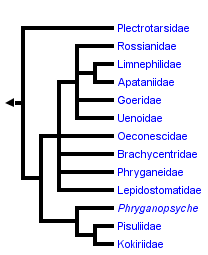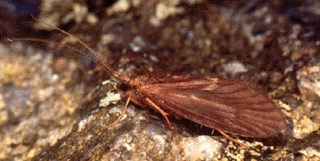Plenitentoria
Ralph W. Holzenthal, Aysha Prather, and Karl Kjer


This tree diagram shows the relationships between several groups of organisms.
The root of the current tree connects the organisms featured in this tree to their containing group and the rest of the Tree of Life. The basal branching point in the tree represents the ancestor of the other groups in the tree. This ancestor diversified over time into several descendent subgroups, which are represented as internal nodes and terminal taxa to the right.

You can click on the root to travel down the Tree of Life all the way to the root of all Life, and you can click on the names of descendent subgroups to travel up the Tree of Life all the way to individual species.
For more information on ToL tree formatting, please see Interpreting the Tree or Classification. To learn more about phylogenetic trees, please visit our Phylogenetic Biology pages.
close boxIntroduction
Ross (1967) divided the Integripalpia into a Limnephiloid branch and a Leptoceroid branch, and Weaver (1984) named these branches Plenitentoria and Brevitentoria, respectively.Discussion of Phylogenetic Relationships
The Plenitentoria have been supported by both morphological (Weaver 1984; Frania and Wiggins, 1997) and molecular data (Kjer et al. 2001, 2002; Holzenthal et al., 2007), although the molecular analyses include the Kokiriidae. Partitioned analyses of nuclear rRNA, Elongation Factor 1 alpha, and mitochodrial COI amino acids all independently support Plenitentoria (Kjer et al. 2001).References
Frania, H.E. & Wiggins, G.B. (1997) Analysis of morphological and behavioural evidence for the phylogeny and higher classification of Trichoptera (Insecta). Life Sciences Contributions, Royal Ontario Museum, 160, 1–67.
Holzenthal, R.W., Blahnik, R.J., Kjer, K.M. & Prather, A.P. (2007) An update on the phylogeny of caddisflies (Trichoptera).In: Bueno-Soria, J., Barba-Alvarez, R. & Armitage, B. (Eds.) Proceedings of the XIIth International Symposium on Trichoptera. The Caddis Press, Columbus, Ohio, pp. 143–153.
Kjer, K.M., Blahnik, R.J. & Holzenthal, R.W. (2001) Phylogeny of Trichoptera (caddisflies): characterization of signal and noise within multiple datasets. Systematic Biology, 50, 781–816.
Kjer, K.M., Blahnik, R.J. & Holzenthal, R.W. (2002) Phylogeny of caddisflies (Insecta, Trichoptera). Zoologica Scripta,31, 83–91.
Ross, H.H. (1967) The evolution and past dispersal of the Trichoptera. Annual Review of Entomology, 12, 169–206.
Title Illustrations

| Scientific Name | Lepidostoma pictile |
|---|---|
| Location | Great Smokey Mountains National Park, North Carolina, USA |
| Specimen Condition | Live Specimen |
| Image Use |
 This media file is licensed under the Creative Commons Attribution-NonCommercial-ShareAlike License - Version 3.0. This media file is licensed under the Creative Commons Attribution-NonCommercial-ShareAlike License - Version 3.0.
|
| Copyright |
© 1997 Ralph W. Holzenthal

|
About This Page
Ralph W. Holzenthal

University of Minnesota, St. Paul, Minnesota, USA
Aysha Prather

Centre for Biodiversity and Conservation Biology, Royal Ontario Museum, Toronto, Ontario, Canada
Karl Kjer

Rutgers University, New Brunswick, New Jersey, USA
Correspondence regarding this page should be directed to Ralph W. Holzenthal at , Aysha Prather at , and Karl Kjer at
Page copyright © 2010 Roger J. Blahnik, Ralph W. Holzenthal, Aysha Prather, and Karl Kjer
 Page: Tree of Life
Plenitentoria.
Authored by
Ralph W. Holzenthal, Aysha Prather, and Karl Kjer.
The TEXT of this page is licensed under the
Creative Commons Attribution-NonCommercial-ShareAlike License - Version 3.0. Note that images and other media
featured on this page are each governed by their own license, and they may or may not be available
for reuse. Click on an image or a media link to access the media data window, which provides the
relevant licensing information. For the general terms and conditions of ToL material reuse and
redistribution, please see the Tree of Life Copyright
Policies.
Page: Tree of Life
Plenitentoria.
Authored by
Ralph W. Holzenthal, Aysha Prather, and Karl Kjer.
The TEXT of this page is licensed under the
Creative Commons Attribution-NonCommercial-ShareAlike License - Version 3.0. Note that images and other media
featured on this page are each governed by their own license, and they may or may not be available
for reuse. Click on an image or a media link to access the media data window, which provides the
relevant licensing information. For the general terms and conditions of ToL material reuse and
redistribution, please see the Tree of Life Copyright
Policies.
- Content changed 20 July 2010
Citing this page:
Holzenthal, Ralph W., Aysha Prather, and Karl Kjer. 2010. Plenitentoria. Version 20 July 2010 (under construction). http://tolweb.org/Plenitentoria/14574/2010.07.20 in The Tree of Life Web Project, http://tolweb.org/







 Go to quick links
Go to quick search
Go to navigation for this section of the ToL site
Go to detailed links for the ToL site
Go to quick links
Go to quick search
Go to navigation for this section of the ToL site
Go to detailed links for the ToL site